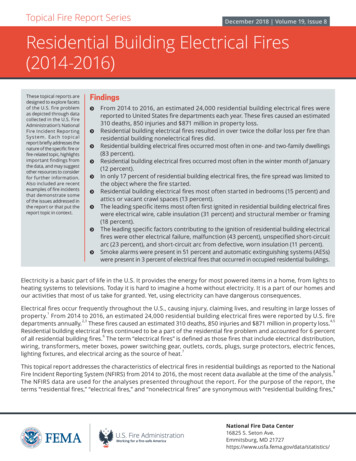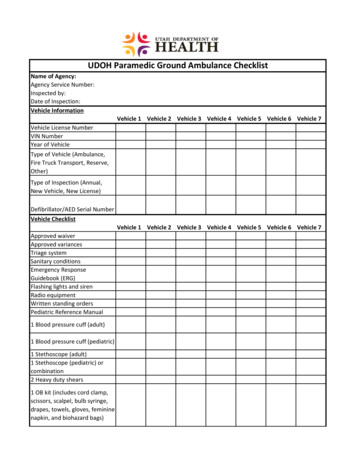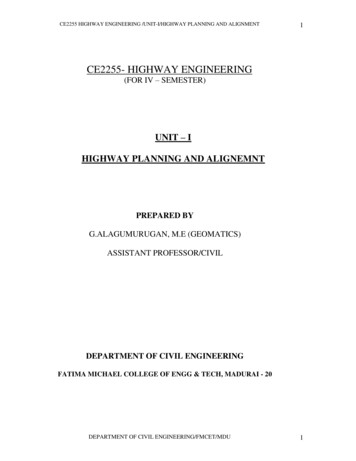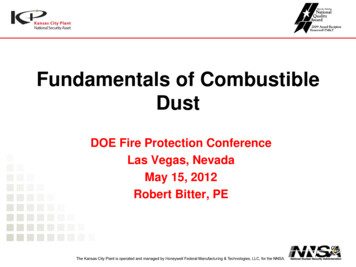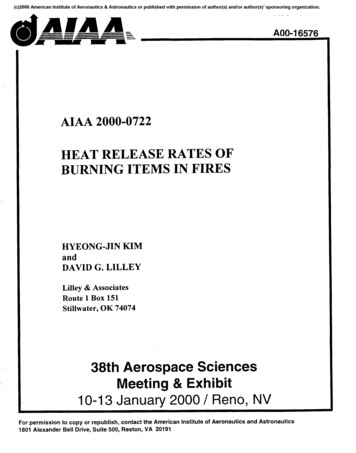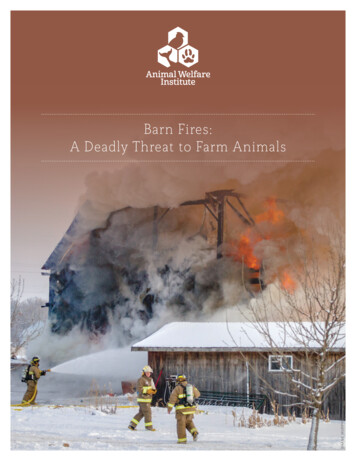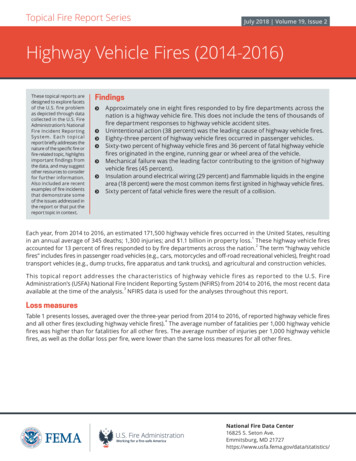
Transcription
Topical Fire Report SeriesJuly 2018 Volume 19, Issue 2Highway Vehicle Fires (2014-2016)These topical reports aredesigned to explore facetsof the U.S. fire problemas depicted through datacollected in the U.S. FireAdministration’s NationalFire Incident ReportingSy s tem . E ach topic alreport briefly addresses thenature of the specific fire orfire-related topic, highlightsimportant findings fromthe data, and may suggestother resources to considerfor further information.Also included are recentexamples of fire incidentsthat demonstrate someof the issues addressed inthe report or that put thereport topic in context.FindingsĵĵĵĵĵĵĵApproximately one in eight fires responded to by fire departments across thenation is a highway vehicle fire. This does not include the tens of thousands offire department responses to highway vehicle accident sites.Unintentional action (38 percent) was the leading cause of highway vehicle fires.Eighty-three percent of highway vehicle fires occurred in passenger vehicles.Sixty-two percent of highway vehicle fires and 36 percent of fatal highway vehiclefires originated in the engine, running gear or wheel area of the vehicle.Mechanical failure was the leading factor contributing to the ignition of highwayvehicle fires (45 percent).Insulation around electrical wiring (29 percent) and flammable liquids in the enginearea (18 percent) were the most common items first ignited in highway vehicle fires.Sixty percent of fatal vehicle fires were the result of a collision.Each year, from 2014 to 2016, an estimated 171,500 highway vehicle fires occurred in the United States, resulting1in an annual average of 345 deaths; 1,300 injuries; and 1.1 billion in property loss. These highway vehicle fires2accounted for 13 percent of fires responded to by fire departments across the nation. The term “highway vehiclefires” includes fires in passenger road vehicles (e.g., cars, motorcycles and off-road recreational vehicles), freight roadtransport vehicles (e.g., dump trucks, fire apparatus and tank trucks), and agricultural and construction vehicles.This topical report addresses the characteristics of highway vehicle fires as reported to the U.S. FireAdministration’s (USFA) National Fire Incident Reporting System (NFIRS) from 2014 to 2016, the most recent data3available at the time of the analysis. NFIRS data is used for the analyses throughout this report.Loss measuresTable 1 presents losses, averaged over the three-year period from 2014 to 2016, of reported highway vehicle fires4and all other fires (excluding highway vehicle fires). The average number of fatalities per 1,000 highway vehiclefires was higher than for fatalities for all other fires. The average number of injuries per 1,000 highway vehiclefires, as well as the dollar loss per fire, were lower than the same loss measures for all other fires.National Fire Data Center16825 S. Seton Ave.Emmitsburg, MD 21727https://www.usfa.fema.gov/data/statistics/
TFRS Volume 19, Issue 2 Highway Vehicle Fires (2014-2016)Table 1. Loss measures for highway vehicle fires (three-year average, 2014-2016)MeasureAll fires(excluding highway vehicle fires)Highway vehicle firesAverage loss:Fatalities/1,000 fires2.92.2Injuries/1,000 fires4.410.7 7,290 10,290Dollar loss/fireSource: NFIRS 5.0.Notes: 1. Average loss for fatalities and injuries is computed per 1,000 fires. Average dollar loss is computed per fire and is rounded to the nearest 10.2. The 2014 and 2015 dollar-loss values were adjusted to 2016 dollars.Types of highway vehicle firesThe majority of highway vehicle fires, 83 percent, occurred in passenger road vehicles: 66 percent occurred in5standard passenger vehicles, 17 percent occurred in some other type of passenger vehicle, and less than 1 percentoccurred in buses. Only 10 percent of highway vehicle fires occurred in nonpassenger vehicles: 9 percent occurred in6transport vehicles, with freight road transportation vehicles accounting for the majority of these fires, and 1 percentoccurred in other types of vehicles, such as construction vehicles, farm tractors and special purpose vehicles. In theremaining 7 percent of highway vehicle fires, the type of vehicle was not reported (Table 2).Table 2. Types of highway vehicle fires (2014-2016)Type of vehiclePercent of highway vehicle firesPassenger road vehicle83.3Passenger vehicle65.8Passenger or road vehicles, other16.9BusesTransport vehicle0.68.9Freight road transport vehicle8.8Rail transport vehicle0.1Water transport vessel 0.1Air transport vehicle 0.1Other vehicle0.8Mobile property, other0.4Industrial, construction, agricultural vehicles0.3Special purpose vehicle0.1No entry/UndeterminedTotal7.0100.0Source: NFIRS 5.0.Note:No entry/Undetermined includes incidents where the mobile property type was designated as “None.”When highway vehicle fires occurAs shown in Figure 1, highway vehicle fires mainly occurred in the afternoon and evening hours, peaking from 2 to 67p.m. (24 percent). Highway vehicle fires occurred the least often in the morning hours from 4 to 6 a.m. (5 percent).2
TFRS Volume 19, Issue 2 Highway Vehicle Fires (2014-2016)7.06.05.13.43.03.1 3.02.82.5 2.5 2.74 - 5 a.m.4.03 - 4 a.m.5.03.13.4 3.64.05.45.96.36.1 6.05.54.94.54.5 4.33.93.62.01.011 p.m. - Mid10 - 11 p.m.9 - 10 p.m.8 - 9 p.m.7 - 8 p.m.6 - 7 p.m.5 - 6 p.m.4 - 5 p.m.3 - 4 p.m.2 - 3 p.m.1 - 2 p.m.12 - 1 p.m.11 a.m. - 12 p.m.10 - 11 a.m.9 - 10 a.m.8 - 9 a.m.7 - 8 a.m.6 - 7 a.m.5 - 6 a.m.2 - 3 a.m.1 - 2 a.m.0.0Mid - 1 a.m.Percent of highway vehicle firesFigure 1. Highway vehicle fires by time of alarm (2014-2016)Time of alarmSource: NFIRS 5.0.Note:Total percent does not add up to 100 percent due to rounding.Figure 2 shows that while highway vehicle fires occurred nearly uniformly throughout the year, the number of thesefires were slightly higher during the months of May through August (36 percent). It is possible this slight peak maybe due to elevated outdoor temperatures or increased vehicle use, as many individuals and families take vacationsduring these .02.0Month of yearAugustJulyJuneMayFebruary0.0JanuaryPercent of highway vehicle firesFigure 2. Highway vehicle fires by month (2014-2016)Source: NFIRS 5.0.3
TFRS Volume 19, Issue 2 Highway Vehicle Fires (2014-2016)Causes of highway vehicle firesAs shown in Figure 3, unintentional actions accounted for 38 percent of highway vehicle fires. These fires may bethe result of either careless behavior or accidental actions. Fires caused by intentional actions constituted only 58percent of highway vehicle fires. The NFIRS no longer collects information on suspicious fires that may have been9intentionally set. As a result, fires caused by intentional actions may be undercounted. Moreover, due to the volumeof fires, many automobile fires are not investigated for possible arson.Determining the cause of vehicle fires is often challenging. As a result, in 23 percent of highway vehicle fires, no causewas determined after an investigation. The failure of equipment or the heat source was the cause in an additional21 percent of highway vehicle fires. These fires are generally a result of mechanical problems, ranging from a faultydesign in the vehicle to an improperly installed device.Figure 3. Causes of highway vehicle fires (2014-2016)37.6Unintentional37.423.1Cause undeterminedafter investigation23.021.0CausesFailure of equipmentor heat source20.810.2Cause under investigation10.25.0IntentionalPercent of highway vehicle fires withcause of ignition determined5.0Percent of all highway vehicle fires2.8Exposure2.80.30.3Act of Percent of highway vehicle firesSource: NFIRS 5.0.Note:Total percent of all highway vehicle fires does not add up to 100 percent due to rounding.Where highway vehicle fires start (area of fire origin)As expected, the majority (93 percent) of highway vehicle fires originated within the vehicle itself. In fact, 62 percent10of highway vehicle fires originated specifically in the engine, running gear, or wheel areas of the vehicle (Table 3).The second most common area of fire origin was in the operator/passenger area of the vehicle (12 percent).4
TFRS Volume 19, Issue 2 Highway Vehicle Fires (2014-2016)Table 3. Areas of fire origin in highway vehicle fires (2014-2016)Areas of fire originTransportation, vehicle areasPercent of highway vehicle fires(unknowns apportioned)93.1Engine area, running gear, wheel area62.2Operator/Passenger area of transportation equipment12.3Other vehicle areas8.7Cargo/Trunk area — all vehicles4.6Exterior, exposed surface of vehicle3.4Fuel tank, fuel line1.6Separate operator/control area of transportation equipment0.3All other areasTotal6.9100.0Source: NFIRS 5.0.How highway vehicle fires start (heat source)Figure 4 shows heat source categories for highway vehicle fires. The “heat from powered equipment” category11accounted for 63 percent of highway vehicle fires. Fittingly, the subcomponents of this category are comprised offour of the top five specific sources of heat in all highway vehicle fires — heat from miscellaneous powered equipment(22 percent); radiated or conducted heat from operating equipment (17 percent); electrical arcing (16 percent); andspark, ember or flame from operating equipment (8 percent).The next leading heat source category in highway vehicle fires was “hot or smoldering object” (13 percent). Thiscategory includes items such as hot or smoldering objects (5 percent) and sparks that result from friction, includingoverheated tires (5 percent). The third leading heat source category is “other heat source” (9 percent), which includesmiscellaneous items.An additional 7 percent of highway vehicle fires derived their heat source from items that fell under the “heat fromopen flame or smoking material” category. This category includes backfire from the engine and heat from cigarettes,cigars, matches, torches and the like.5
TFRS Volume 19, Issue 2 Highway Vehicle Fires (2014-2016)Figure 4. Sources of heat in highway vehicle fires by major category (2014-2016)63.0Heat from powered equipment27.312.5Hot or smoldering objects5.48.9Other heat source3.86.9Heat from open flameor smoking material3.0Heat spread from another fire2.5Multiple heat sources includingmultiple ignitions1.10.5Explosive, fireworks1.00.45.7Percent of highway vehicle fires withheat source determinedPercent of all highway vehicle fires0.9Chemical, natural heat .070.0Percent of highway vehicle firesSource: NFIRS 5.0.Note:Total percent of all highway vehicle fires does not add up to 100 percent due to rounding.What ignites first in highway vehicle firesForty-six percent of the items first ignited in highway vehicle fires fell under the category of “general materials”12(Figure 5). This category includes materials such as tires, insulation around electric wire and cables, trash, and fabric.Specifically, insulation around the electrical wiring or other cables was the most common item to initially ignite, not onlywithin this category but in all highway vehicle fires (29 percent). While it is often assumed that vehicle fires commonlyoriginate with the tires of the vehicle, tires were the item first ignited in only 6 percent of all highway vehicle fires.The second leading category of items first ignited was “liquids, piping, filters” (26 percent). This category primarilyincludes fuel in various locations in the vehicle. Due to its combustibility, fuel from the engine area was the leadingspecific item first ignited within this category and was the second most common specific item first ignited in highwayvehicle fires overall (18 percent). In general, flammable liquids and gases accounted for 24 percent of items first ignited.6
TFRS Volume 19, Issue 2 Highway Vehicle Fires (2014-2016)Figure 5. Item first ignited in highway vehicle fires by major category (2014-2016)46.3General materials16.226.2Liquids, piping, filters9.216.2Other items5.75.8CausesFurniture, utensils2.02.71.0Organic materialsStorage suppliesAdornment, recreational materials, signsPercent of highway vehicle fires withitem first ignited determined1.60.6Soft goods, wearing apparelPercent of all highway vehicle 0.050.060.070.0Percent of highway vehicle firesSource: NFIRS 5.0.Note:Total percent of all highway vehicle fires does not add up to 100 percent due to rounding.Factors contributing to ignition in highway vehicle firesTable 4 shows categories of the factors contributing to the ignition of highway vehicle fires. Mechanical failure ormalfunction was the leading contributing factor of highway vehicle fires (45 percent). These mechanical failuresinclude a leak or break in a component of the vehicle, automatic or manual control failures, or the use of an impropertype of fuel. An electrical failure or malfunction, such as a short circuit, was a contributing factor in 21 percent ofhighway vehicle fires. The misuse of a material or product, such as spilling flammable liquid or gas too close tothe vehicle, was the third leading factor contributing to the ignition of the fires (13 percent). These three leadingcontributing factors played a role in 79 percent of highway vehicle fires.7
TFRS Volume 19, Issue 2 Highway Vehicle Fires (2014-2016)Table 4. Factors contributing to ignition for highway vehicle fires by major category (where factorscontributing to ignition are specified, 2014-2016)Factor contributing to ignition categoryPercent of highway vehicle fires(unknowns apportioned)Mechanical failure, malfunction44.8Electrical failure, malfunction21.4Misuse of material or product12.9Fire spread or control8.5Operational deficiency8.4Other factors contributing to ignition6.6Natural condition0.8Design, manufacture, installation deficiency0.7Source: NFIRS 5.0.Notes: 1. Includes only incidents where factors that contributed to the ignition of the fire were specified.2. Multiple factors contributing to fire ignition may be noted for each incident; total will exceed 100 percent.Fatal highway vehicle firesLess than 1 percent of all highway vehicle fires were fatal. Of the fatal highway vehicle fires, 86 percent resulted in asingle fatality and 14 percent resulted in multiple fatalities. While some of the characteristics of these fatal highwayvehicle fires are similar to all highway vehicle fires, others are markedly different.Unlike all highway vehicle fires, fatal highway vehicle fires mainly occurred in the very early morning hours betweenmidnight and 5 a.m. (33 percent). The highest percentages of deaths occurred between midnight and 1 a.m. (8percent), 2 to 3 a.m. (7 percent), and 3 to 4 a.m. (7 percent). In addition, unlike all highway vehicle fires that occurredmore uniformly, fatal highway vehicle fires occurred with more variation throughout the year. Noticeable peaksoccurred in May (10 percent), August (10 percent), and October and November (each at 11 percent). Additionally, fatalhighway vehicles fires occurred least often in January (5 percent).Unintentional action was the leading cause, as it was for all highway vehicle fires, and accounted for 42 percent of fatalhighway vehicle fires. In 35 percent of fatal highway vehicle fires, the cause was still under investigation. The causewas undetermined in 12 percent, while intentional action was the cause in 6 percent of fatal highway vehicle fires.Where the information on the area of fire origin was available, 93 percent of fatal highway fires originated in thevehicle area and resulted in 93 percent of highway vehicle fire deaths. The leading specific area of origin in both fatalhighway vehicle fires and all highway vehicle fires was the engine area, at 36 percent and 62 percent, respectively.Fires that originated in the engine area were by far the deadliest, accounting for 35 percent of all deaths. Fires thatoriginated in the fuel tank accounted for only 2 percent of all highway vehicle fires but 12 percent of fatal highwayvehicle fires and 14 percent of deaths.The leading heat source category for fatal highway vehicle fires with a known origin was “powered equipment” (48percent), accounting for 47 percent of highway vehicle fire deaths. The leading specific heat sources for fatal highwayvehicle fires were heat from miscellaneous powered equipment (15 percent); spark, ember or flame from poweredequipment (15 percent); and radiated or conducted heat (15 percent).Where the necessary data were available, the leading category of items first ignited in fatal highway vehicle fires was“liquids, piping, filters” (65 percent). Flammable liquids and gases in general were, by far, the most deadly (67 percentof deaths). Specifically, fuel in or from the engine area was the second leading item first ignited in all highway vehiclefires (18 percent) but was, by far, the leading item in both fatal fires (43 percent) and deaths (45 percent). Additionally,insulation around electrical wiring or cables was responsible for 29 percent of all highway vehicle fires, but only 2percent of fatal fires and 2 percent of deaths.8
TFRS Volume 19, Issue 2 Highway Vehicle Fires (2014-2016)Collisions, as a factor contributing to ignition, resulted in 5 percent of all highway vehicle fires but were responsiblefor 60 percent of fatal highway vehicle fires. Fatal fires resulting from collisions accounted for 62 percent of highwayvehicle fire deaths. Determining the cause of death following a collision can be difficult as the death may have beeneither the direct result of the collision or the fire that ensued. A fire fatality should be counted only if a personwas trapped and killed by the fire, rather than killed on impact and subsequently exposed to the fire. Unspecifiedmechanical failures contributed to 32 percent of all highway vehicle fires but are rarely fatal, accounting for 4 percentof fatal highway vehicle fires and 3 percent of deaths.ExamplesThe following are recent examples of highway vehicle fires reported by the media:ĵĵMarch 2018: A truck fire caused all southbound lanes of Interstate 85 in Davidson County, North Carolina, to beclosed to traffic. The truck was involved in an accident around 7:08 a.m. Soon thereafter, two men who wereinside the truck noticed the hood on fire. Fire crews arrived on scene and removed a leaking propane tank from13the truck. No injuries were reported.ĵĵFebruary 2018: A motorcycle beside a house in Greensboro, North Carolina, caught fire and caused one injury.When firefighters arrived to the early evening fire, it was already extinguished. However, they found one personwho suffered burns while trying to put out the fire. The condition of the injured person who was transported to14a hospital was unknown. In addition, the cause of the fire was not reported.ĵĵJanuary 2018: After going in for routine maintenance a day earlier, a Lakeside, California, fire truck caught firewhile parked in a repair garage behind a fire station. Paramedics discovered smoke coming from the repair garageand found the cab of the fire truck engulfed in flames. Firefighters were able to quickly extinguish the blaze andkept it from spreading beyond the truck. Fire officials said that it appeared the fire was electrical in nature andstarted underneath the cab area. While no injuries were reported, the truck, worth approximately 550,000, was15a total loss. In addition, damage to items inside the truck were estimated to be between 60,000 and 100,000.ĵĵMay 2017: A vehicle was parked on a city block in New York, New York, and had not been driven for about aweek. When the owner of the vehicle went to drive it, he noticed his engine was overheating and then abruptlycaught fire. He exited the vehicle, opened the hood, and discovered two deceased baby rats on the ledge of theengine. Firefighters soon arrived at the scene and extinguished the fire. Further investigation by firefighters found16additional rats in the rims of the vehicle’s tire.What to do in case of a highway vehicle fireIt is important to know what to do in the event that you have a highway vehicle fire. First, get yourself and all othersout of and safely away from the vehicle. Never attempt to get back into the vehicle to retrieve personal property. Callyour fire department at 911 or your local emergency telephone number. Next, if you choose to use a fire extinguisher,do so at a safe distance from the vehicle and use a fire extinguisher approved for Class B and Class C fires. In addition,never open the hood or trunk if you suspect a fire under it, as air could cause the fire to enlarge. Finally, at all times,be aware of other vehicles on the roadway and never stand on an active roadway as there is the potential dangerof being struck by another vehicle. For more information on the prevention of and actions to take when you have ahighway vehicle fire, visit ns/fa-243.pdf.NFIRS data specifications for highway vehicle firesData for this report were extracted from the NFIRS annual Public Data Release files for 2014, 2015 and 2016. Onlyversion 5.0 data were extracted.Highway vehicle fires were defined by the following criteria:ĵĵAid Types 3 (mutual aid given) and 4 (automatic aid given) were excluded to avoid double counting of incidents.9
TFRS Volume 19, Issue 2 Highway Vehicle Fires (2014-2016)ĵĵIncident Types 131, 132, 136 and 137:IncidentTypeĵĵDescription131Passenger vehicle fire132Road freight or transport vehicle fire136Self-propelled motor home or recreational vehicle when being used in a transport mode137Camper or recreational vehicle, (RV), not self-propelled (includes trailers)Mobile property involved codes 1 (not involved in ignition but burned) and 3 (involved in ignition and burned).Special considerationsOne of the challenges in the analysis of NFIRS highway vehicle fire data is the large number of unknown orundetermined entries reported, as well as missing data values. For example, in the analysis of the heat source anditems first ignited in highway vehicle fires, the undetermined entries comprise 57 percent and 65 percent of thedata, respectively. The large percentages of unknown and missing data make it difficult to establish any concreteconclusions in these particular analyses.The analyses contained in this report reflect the current methodologies used by the USFA. The USFA is committedto providing the best and most current information on the U.S. fire problem and continually examines its data andmethodology to fulfill this goal. Because of this commitment, data collection strategies and methodological changesare possible and do occur. As a result, analyses and estimates of the fire problem may change slightly over time.Previous analyses and estimates on specific issues (or similar issues) may have used different methodologies or datadefinitions and may not be directly comparable to the current ones.To request additional information, visit https://www.usfa.fema.gov/contact.html. To comment on this specific report,visit reportTitle Highway%20Vehicle%20Fires%20(2014-2016).Notes:As highway vehicles are a major property class, the national estimates are based only on the National Fire Protection Association’s (NFPA)annual survey, “Fire Loss in the United States.” Fires are rounded to the nearest 100, deaths to the nearest five, injuries to the nearest 25, andloss to the nearest hundred million dollars.2The percentage shown here is derived from the NFPA’s national estimate of highway vehicle fires and the summary data resulting from NFPA’sannual fire-loss surveys (Haynes, Hylton, J.G., “Fire Loss in the United States During 2016,” NFPA, September 2017; “Fire Loss in the United StatesDuring 2015,” NFPA, September 2016; “Fire Loss in the United States During 2014,” NFPA, September 2015). This percentage differs from thatderived from the NFIRS data alone. Highway vehicle fires accounted for 12 percent of all fires reported to the NFIRS.3Fire department participation in the NFIRS is voluntary; however, some states do require their departments to participate in the state system.Additionally, if a fire department is a recipient of a Fire Act Grant, participation is required. From 2014 to 2016, 68 percent of the NFPA’s annualaverage estimated 1,328,500 fires, to which fire departments responded, were captured in the NFIRS. Thus, the NFIRS is not representative ofall fire incidents in the U.S. and is not a “complete” census of fire incidents. Although the NFIRS does not represent 100 percent of the incidentsreported to fire departments each year, the enormous dataset exhibits stability from one year to the next, without radical changes. Resultsbased on the full dataset are generally similar to those based on part of the data.4The average fire death and fire injury loss rates, computed from the NFPA estimates above, do not agree with average fire death and fire injuryloss rates computed from the NFIRS data alone. The fire death rate computed from NFPA estimates is (1,000 x (345/171,500)) 2.0 deaths per1,000 highway vehicle fires, and the fire injury rate is (1,000 x (1,300/171,500)) 7.6 injuries per 1,000 highway vehicle fires.5Based on the mobile property type field in the NFIRS, standard passenger vehicles include cars, ambulances, limousines, race cars, taxis, off-roadrecreational vehicles, motor homes, travel trailers, camping trailers, mobile homes and motorcycles. Pickup trucks, however, are excluded fromthis category but are included with the freight road transport vehicles. For more specific definitions of vehicle types, please see the mobileproperty type codes in the NFIRS 5.0 Complete Reference Guide (CRG): .6Based on the mobile property type field in the NFIRS, freight road transport vehicles include general use trucks, dump trucks, pickup trucks,fire apparatus, trailers, tank trucks and garbage trucks.7For the purposes of this report, the time of the fire alarm is used as an approximation for the general time at which the fire started. However,in the NFIRS, it is the time at which the fire was reported to the fire department.110
TFRS Volume 19, Issue 2 Highway Vehicle Fires (2014-2016)Fires caused by intentional actions include, but are not limited to, fires that are deemed to be arson. Intentional fires are those fires that aredeliberately set and include fires that result from the deliberate misuse of a heat source and fires of an incendiary nature (arson) that requirefire service intervention. For information and statistics on arson fires only, refer to the Uniform Crime Reporting Program arson statistics fromthe U.S. Department of Justice, FBI, Criminal Justice Information Services Division, http://www.fbi.gov/about-us/cjis/ucr/ucr.9While the term “suspicious” is not used in NFIRS Version 5.0, information is collected on fires that may be intentionally set and may be suspiciousor believed to be arson. These fires can be coded as fires “under investigation.” However, not all fires coded as “under investigation” arenecessarily suspicious or believed to be arson.10The running gear of a vehicle generally refers to components that transfer power from the engine and deliver it to the wheels, e.g., transmission,drive shaft, differential.11See the Special Considerations section at the end of this report for a discussion of unknown, undetermined and missing data.12See the Special Considerations section at the end of this report for a discussion of unknown, undetermined and missing data.13“Vehicle Fire Closes All Lanes of I-85 Southbound in Davidson County; SkyView8 Video Shows Huge Backup,” www.myfox8.com, March 22, y/ (accessed March 28, 2018).14“Person Injured After Motorcycle Catches Fire In Greensboro,” www.myfox8.com, February 27, 2018, otorcycle-catches-fire-in-greensboro/ (accessed March 28, 2018).15Teri Figueroa, “Lakeside Fire Truck Destroyed In Possible Electrical Fire,” www.sandiegouniontribune.com, January 26, 2018, fety/sd-me-fire-truck-fire-20180126-story.html, (accessed March 28, 2018).16Ben Hooper, “Rats Blamed for New York Car Fire That Drew Tony Hawk’s Attention,” www.upi.com, May 3, 2017, re-that-drew-Tony-Hawks-attention/2991493828395/ (accessed March 28, 2018).811
Eighty-three percent of highway vehicle fires occurred in passenger vehicles. ĵ. Sixty-two percent of highway vehicle fires and 36 percent of fatal highway vehicle fires originated in the engine, running gear or wheel area of the vehicle. ĵ. Mechanical failure was the leading factor contributing to the ignition of highway vehicle fires (45 .

